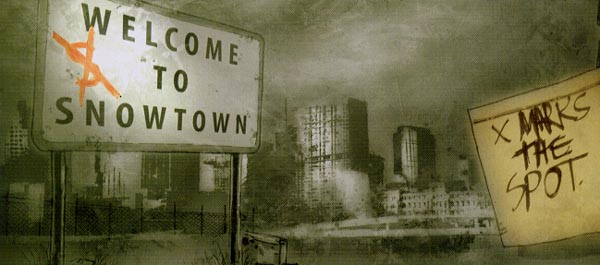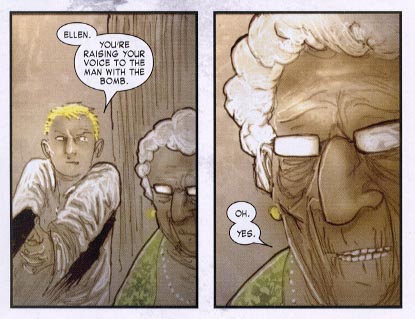 Written by Warren Ellis
Written by Warren Ellis
Art by Ben Templesmith
20 pages, color
Published by Image Comics
In many ways, Fell is an experiment. It’s a series of 16-page stories in comics, each intended to be self-contained, and priced at just $1.99. Can a cheaper-and-shorter series work, not only financially, but to the reader’s satisfaction?
Detective Richard Fell’s just transferred across the river into Snowtown, which could charitably be called a cesspool. Deliveries slow down whenever the truck drivers get mugged, there are only three-and-a-half detectives for the entire precinct, and the vast majority of people living in Snowtown appear to be mentally imbalanced at best. Welcome to Snowtown, Detective Fell.
The bulk of the work for Fell really seems to go to Warren Ellis, trying to create self-contained 16-page detective stories. While it’s nothing against the amount of work that artist Ben Templesmith puts into the series, Fell is a book that will ultimately succeed or fail based on Ellis’s writing. In many ways, the trickiest is the first issue; it’s not only trying to tell a story, but to also introduce us to Detective Fell, to Snowtown, and to the rest of the characters involved. With the introductions, Fell #1 definitely succeeds; you get a real feel for Fell and the kind of person he’s in even as he stumbles through his new life as a detective in Snowtown. As a story? That’s a bit trickier. Fell #1 feels like it spends too much time on witty monologues early on (like the woman whose husband left her for the dog, or Lieutenant Beard’s ramblings) and not enough on the case itself. Fell seems to literally walk right into the answers; it’s hard to be impressed with a detective that’s almost told every single piece of the puzzle in order for him to solve it.

It’s early in the series, though, and it’s a hard balance to strike for a first issue. As the second and third issues proceed, that balance is found more and more. The second issue in many ways is a continuation of the first on a character level, dealing with the aftermath of Fell’s being branded as well as using that to his advantage. Fell’s once again told a critical piece of information by someone else, but here it feels more natural, like he’s actually doing detective work instead of finding a solution in front of him. Fell #3 is by far the strongest yet in writing; we’re still getting a real feel for Snowtown and its denizens, but it no longer feels like it’s at the cost of the plot. Fell’s showdown with a bomber is clever, has some great character moments and dialogue (“You’re raising your voice to the man with the bomb.” “Oh.”), and above all else, the solution is entirely one of Fell’s doing. With this issue, the series in many ways completely clicked for me. The balance between the two halves of Fell is there, and it made me the most eager yet to see the next issue.
 Templesmith’s art has over the years strengthened, and is one of the few artists who can really use a 9-panel grid. Templesmith sold me on his ability to use a lot of panels on a single page when working with Matt Fraction on 30 Days of Night: Bloodsucker Tales, and he uses it to great effect here. He’s able to control the reader’s eye by often using the smaller panels as literally looking through Fell’s eyes, letting us see what he’s seeing. It’s a lot of tight focuses on characters, and Templesmith’s keeping them looking entertaining enough to keep the reader’s attention. Snowtown itself is a character under Templesmith’s artistic endeavors; with a murky, almost muddy color palette you always get a real sense of the oppressive gloom that hangs over this forsaken area, and what it’s really like to live there. In many ways, it’s the most memorable visual of the series.
Templesmith’s art has over the years strengthened, and is one of the few artists who can really use a 9-panel grid. Templesmith sold me on his ability to use a lot of panels on a single page when working with Matt Fraction on 30 Days of Night: Bloodsucker Tales, and he uses it to great effect here. He’s able to control the reader’s eye by often using the smaller panels as literally looking through Fell’s eyes, letting us see what he’s seeing. It’s a lot of tight focuses on characters, and Templesmith’s keeping them looking entertaining enough to keep the reader’s attention. Snowtown itself is a character under Templesmith’s artistic endeavors; with a murky, almost muddy color palette you always get a real sense of the oppressive gloom that hangs over this forsaken area, and what it’s really like to live there. In many ways, it’s the most memorable visual of the series.
After being a little unsure about the first issue of the series, I’m now quite sold on Fell. Each issue’s felt like it’s gotten stronger and more used to this format, and this continual improvement and refinement bodes well for future issues of the series. Best of all, Fell is just under two dollars an issue, one of the cheapest comics on the stands these days. It’s a low-cost way to take a look for yourself. You’d never want to live in the world of Fell, but it’s a great location for a brief visit courtesy of Ellis and Templesmith. All aboard.
